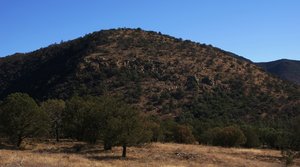Advertisement
Published: January 16th 2013

 BATTLEFIELD
BATTLEFIELD
From First Street and Fremont in Tombstone proceed southeast on Hwy 80 to Davis Rd. Turn left and follow Davis Rd plumb out past McNeil to Leslie Canyon Rd. Follow Leslie Canyon to Rucker Canyon Rd. Turn left on East Rucker Canyon Rd towards Rucker Lake. Go across the creek and past the forest circus place to a little camp ground on the right about 3.5 miles from where you turned. The core of the battlefield is on the rocky hillside. Take pictures only. RUCKER BASIN
This story begins with a fellow named Col John Finkle Stone. He did not attend West Point, but he did attain the lofty position of Adjutant General in the Department of New Mexico. Col Edward R. S. Canby was the commander of the department in 1862 when the Confederate invasion took place. When his pal Sibley was defeated at Glorieta Pass and the bedraggled rebs headed back to Texas Col Canby was re-assigned and command of the department went to Col Carleton. Stone got pissed off and resigned his commission, moved to Albuquerque and operated the Union Hotel. After the War Between the States ended he sold his interest in the hotel and moved to Tucson. Stone Avenue is named in his honor because he built the first home on it. He didn’t stay in Tucson very long before he took up an interest in mining, moved to Apache Pass and struck a promising lode. As a former officer he readily made friends among the soldiers at Fort Bowie as he was developing his mine workings. Business affairs took him back to Tucson in early October of 1869. On October 5 the stagecoach he

 COCHISE WITHDREW
COCHISE WITHDREW
Go back to N. Rucker Canyon Rd and turn left onto Tex Canyon Rd. The ruins of Fort Rucker will be on the left about half a mile down. There isn't much to see there. Continue southward about 8 miles to the gap where Cochise withdrew from his fight with Winters.was riding on was attacked near the Dragoon Station by Cochise and his merry band. Stone, the driver, and the 4 man military escort were all massacred. The Apaches next attacked a military supply train that was approaching from the west, and then a group of drovers in Sulphur Springs Valley and they made off with a good sized herd of cattle. The supply train found the stagecoach victims, buried them on the spot and notified Fort Bowie upon arrival there of the recent depredations. Lt William H. Winters and Troop G, of the First Cavalry rode off in pursuit on October 8 guided by the scout Merijilda Grijalva. Other soldiers went back to retrieve the bodies buried by the supply train and transplant them in the best military tradition to the cemetery at Fort Bowie. Grijalva quickly found the trail of the cattle herd. It was the easiest trail to follow that any Apache ever left and the soldiers caught up with the herd near Tex Canyon at the south end of the Chiricahuas the following morning. The cattle were recovered after a brief engagement with the rear guard. Cochise scampered off northward through a small gap and Winters

 WINTERS
WINTERS
Continue south another three Quarters of a mile. Just above a major curve in the roadway stop and look to the west. Winters fight took place in the small basin about 0.3 miles from the road. It is on private property. Continue on your merry way another six miles or so to Hwy 80. You are on your own from there.retreated with the cattle. Back at Fort Bowie a larger pursuit force was gathered from Camps Crittenden and Goodwin and set off under command of Captain Reuben F. Bernard. He started out in his military career as a private and rose to first sergeant in his company. During the War Between the States he attained an officer’s commission and retired as a brigadier general; along the way he fought in 103 engagements. He was, of course, a shameless self-promoter and was not shy about trampling the efforts of other officers when it might serve him well to do so. On October 18, 1869 Bernard and his command reached the scene of the Winters’ engagement, and the scout Grijalva began following Cochise northward. It was a large group that left an easy trail. Next day Bernard’s force made contact with Cochise and a sharp engagement ensued. Cochise was in a strong defensive position on a rocky hillside and could not be driven off or flanked. Bernard withdrew with few casualties and Cochise scattered into Mexico. All of the soldiers who participated in flanking assault were awarded the Congressional Medal of Honor. It was the last pitched battle that Cochise fought with

 JOHN F STONE
JOHN F STONE
The gravesite is in the cemetery at Fort Bowie. When the fort closed down the soldiers graves were moved elsewhere, but the civilians were left in place. One of Geronimo's children is also buried there. the Army; it brought him to the conviction that there was no safe haven for him on either side of the border. After this fight Cochise began to actively seek peace.
Advertisement
Tot: 0.258s; Tpl: 0.012s; cc: 12; qc: 51; dbt: 0.1545s; 1; m:domysql w:travelblog (10.17.0.13); sld: 1;
; mem: 1.1mb

 BATTLEFIELD
BATTLEFIELD
 COCHISE WITHDREW
COCHISE WITHDREW
 WINTERS
WINTERS
 JOHN F STONE
JOHN F STONE
